16 - 26 of 26 records
JM-W024: In the Allied camp
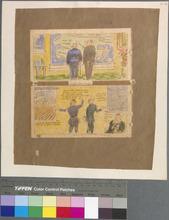
Description:
Editorial cartoon depicting Churchill and FDR looking at a map of Europe in the top panel. In the bottom panel, Hitler, Togo, and Mussolini worry about the plane production in the U.S. as the "unpredictable" factor compared to their U-boats.
Member of:
McCutcheon Editorial Cartoons - ALL (Collection)
Resource Type:
Still Image
JM-282: The interrupted merger
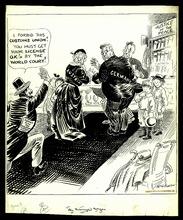
Description:
Editorial cartoon depicting the wedding of Austria and Germany stopped by France.
Member of:
McCutcheon Editorial Cartoons - ALL (Collection)
Resource Type:
Still Image
JM-164: Will there be enough to go round?
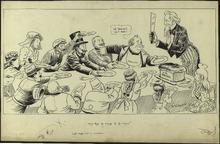
Description:
This cartoon depicts Uncle Sam trying to divide "U.S. Bread" among various nations. In 1915, World War I was being fought in Europe, but the United States was maintaining a neutral position. Despite its neutrality, the United States supplied resources and arms to nations during the war. All of the countries sitting at the table are nations who lobbied for resources from the United States during the war. England is attempting to block Germany's chance of receiving resources from Uncle Sam. This is representative the attempts of the British government to limit the United States aid to Allied Powers, most often England. The United States is also sitting at the table, looking worried about sharing the beard with other nations. The United States distributing more resources than it could afford was a fear for many Americans in the 1910s. (Summary created by Mary Delano, MU History Intern, Spring 2018)
Member of:
McCutcheon Editorial Cartoons - ALL (Collection)
Resource Type:
Still Image
JM-184: Peace talk

Description:
The cartoon shows the interpreted process of peace talks during World War I. The top panel shows the German people being dragged to peace by the Kaiser Wilhelm II. The second panel shows the Reichstag calling for peace after the kaiser orders them to begin discussions. In 1917, the United States had entered World War I, and Germany's and the Axis powers' chance of victory was becoming smaller and smaller. This made them more willing to negotiate for peace than in previous years of the war. The third panel shows the American stock market falling in value. This drop in the stock market was caused by the peace talks. Supplying weapons and other resources in World War I significantly improved the economy of the United States. Many factories and other means of productions had been created solely to meet the needs of the global conflict. As World War I came to a close, the United States large profits from the war effort began to decline. (Summary created by Mary Delano, MU History Intern, Spring 2018)
Member of:
McCutcheon Editorial Cartoons - ALL (Collection)
Resource Type:
Still Image
JM-178: Pan-Germany is swiftly becoming panicy Germany
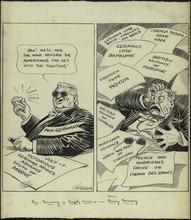
Description:
This cartoon depicts a man who has been affected by news of combat in World War I. In the left panel, "Pan-Germany" is confident about his ability to win the war. Pan-Germany is a concept that stems from the ideology of Pan-Germanism. It is a school of thought, which believes all ethnic Germans and German-speaking people should be united under one state, Pan-Germany. While Pan-Germany was never a real state, Germanic peoples still shared a similar language and culture. In the right panel, Germany quickly becomes alarmed as news of Ally victory comes to his desk. Although Pan-Germany was confident of his ability to win World War I, he did not anticipate the United States becoming a serious threat to the war effort. The United States entered World War I on April 6, 1917. (Summary created by Mary Delano, MU History Intern, Spring 2018)
Member of:
McCutcheon Editorial Cartoons - ALL (Collection)
Resource Type:
Still Image
Absdorf Rentbook.
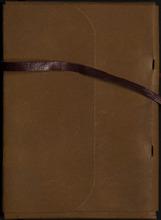
Description:
"[Germany (Absdorf), 1529 and 1549] approximately 52 leaves, c.220mm. by 150mm., nn(a) 26 leaves of soft double-ply paper originally sewn in gatherings but now detached from binding, two columns, 11 lines, in a frame 170mm. by 118mm., written in red and black ink in various sizes of a large formal bookhand, notations in other hands, edges frayed and some leaves separating into their constituent layers, slight thumbing, wrapped in a stronger sheet of paper with the inscription 'Gruntpuech der Zins und Gult zu den Guet Abtstorf gehörig/Renovirt 1528 had der geleichen Hofmaister zu Abtsdorff', nn(b) 24 leaves of strong single-ply paper, collation: i–ii6, iii12, watermark: a gothic 'P' with a shield, close to Briquet, 'Filigranes', no. 8792 (Budweis, 1531), the last 8 leaves are cut away in a stepped fashion on the outer edge to make a thumb index, written in brown ink by various cursive hands, headings in an angular bookhand, some thumbing and signs of use, stitching broken, edges rather battered, wrapper of contemporary paper with inscription 'Grundtbuech Geen Intzlestorff, hern Jorgen Grabner zugehörig angefangen 1549', both loose in nineteenth-century bindingnnCATALOGUE NOTEnnThese documents are two extensive land-registers of the villages of Absdorf and Intzledorf, near St. Pölten in southern Austria, and while land-documents are common, ones of such size and scope are not. Both contain a mass of information on local rents and dues, and details of the produce of the area (mainly wine, cereal, saffron, hens, cheese, hay and garden produce). As well as an intrinsic historical value, these documents have some interest as two different approaches by two local officials to their record keeping. The 'Hofmaister zu Abtsdorff' who created the first book was principally concerned with creating a work of some beauty, allotting each individual landholder a whole page, having the pages ruled for only 11 lines, leaving wide margins, and writing the document (or employing a professional scribe to write it for him) in excellent German script, often with pen flourishes and cadels on the names of the individual landholders. The author of the second book (Jorgen Grabner) was under very different constraints, and produced a document that was functional rather than pleasing to the eye, with numerous additions of scribbled text and tables, crossing-outs, and erasures. This mass of information apparently left him in need of some organisation for his account, and so he added the alphabetical thumb-index. This is an early example of such a referencing system, and is notable for that fact alone."nnSome text & images were too far in the gutter to fully capture.nnFull pdf available, https://dl.mospace.umsystem.edu/mu/islandora/object/mu%3A447642/datastream/PDF/view
Member of:
Resource Type:
Text
German Heraldic Manuscript
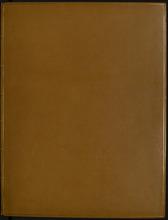
Description:
Armorial manuscript, comprising 5 double-page sheets on thick, good-quality paper and mounted at an early date. 96 shields per page (half a sheet), each finely drawn in pen and ink with original watercolour, names below in brown ink. Light age browning, old damp stain to foot of one sheet, small tearing to one lower corner. A unique volume in modern tan calf with gold tooling, spine with raised bands and double gilt-line decoration. 45 x 34.5 cm
Member of:
Resource Type:
Text
A Newe Mape of Germany
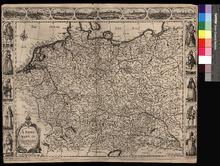
Description:
Appeared in Speed's Prospect of the Most Famous Parts of the World (first published in 1627),On verso: Text: The Description of Germany
Member of:
Venable Maps
Resource Type:
cartographic
A New and Correct Map of the Empire of Germany
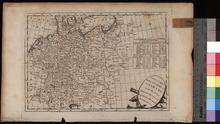
Description:
A variant state of this engraving with the border removed appeared in Moore's A new and complete collection of voyages and travels (1778),On verso: Blank
Member of:
Venable Maps
Resource Type:
cartographic
Circulus Saxoniae Inferioris
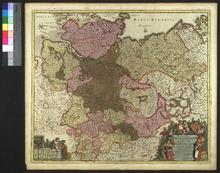
Description:
Also appeared in Nicolaes Visscher's Atlas Minor (first published in 1683).,On verso: Blank
Member of:
Venable Maps
Resource Type:
cartographic
Alchemical recipes
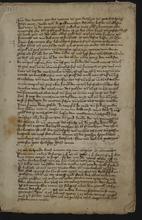
Description:
Manuscript document on paper. Chemistry or alchemy text (mentions multiple ingredients and includes alchemical symbols, and discusses the formula to make gold). Six folios. 27.5 x 18 cm
Member of:
Private Collection of Antiquarian Books and Manuscripts
Resource Type:
Text
Pagination
- Previous page
- Page 2